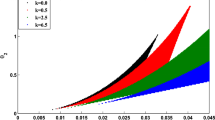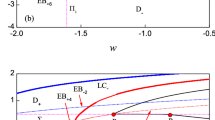Abstract
A birhythmic conductance-based neuronal model with fast and slow variables is proposed to generate and control the coexistence of two different attracting modes in amplitudes and frequencies. However, periodic bursting, chaotic spiking and bursting have not been clearly observed there. The control of bistability is investigated in a three-dimensional birhythmic conductance-based neuronal model. We consider slow processes in neuron materialized by an adaptation variable coupled to system in the presence of an external sinusoidal current applied. By using the harmonic balance method, we obtain the frequency–response curve in which membrane potential resonance with his corresponding frequency is controlled by varying a specific parameter. At the resonance frequency, bifurcation and Lyapunov exponent diagrams versus a control parameter are obtained. They reveal a coexistence of two different complex attractors, namely periodic and chaotic spiking, periodic and chaotic bursting. By using the control parameter as the slow variable, the system can switch from bistable to monostable behavior. This is done by destroying subthreshold (small) oscillation of the neuron. The role of adaptation variable in neuron system is then to filter many existing electrical processes and permit to adapt the system by the multiple transitions states in the chosen electrical mode. A fairly good agreement is observed between analytical and numerical results.














Similar content being viewed by others
Data availability
The data from simulations that support the findings of this study are available on request from the corresponding author RY.
References
Pisarchik, A.N., Feudel, U.: Control of multistability. Phys. Rep. 540, 167 (2014)
Goldbeter, A.: Biochemical oscillations and cellular rythms. In: The Molecular Basis of Periodic and Chaotic Behavior, Cambridge University Press, (1996)
Alamgir, M., Epstein, I.: Systematic design of chemical oscillators: 17—Birhythmicity and compound oscillation in coupled chemical oscillators: chlorite-bromate-iodide system. J. Am. Chem. Soc. 105, 2500 (1983)
Loewenstein, Y., Mahon, S., Chadderton, P., Kitamura, K., Sompolinsky, H., et al.: Bistability of cerebellar Purkinje cells modulated by sensory stimulation. Nat. Neurosci. 8, 202–211 (2005)
Canavier, C.C., Baxter, D.A., Clark, J.W., Byrne, J.H.: Multiple modes of activity in a model neuron suggest a novel mechanism for the effects of neuromodulators. J. Neurophysiol. 72, 872–882 (1994)
Lechner, H., Baxter, D., Clark, C., Byrne, J.: Bistability and its regulation by serotonin in the endogenously bursting neuron R15 in Aplysia. J. Neurophysiol. 75, 957 (1996)
Tagne Nkounga, I., Moukam Kakmeni, F. M., Yamapi, R.: birhythmic oscillations and global stability analysis of a Conductance-based neuronal model under channel fluctuations, submitted in European physical journal plus, (2021)
Moris, C., Lecar, H.: Voltage oscillations in the barnacle giant muscle fiber. Biophys. J . 35, 193–213 (1981)
Fitzhugh, R.: Impulses and physiological states in theoretical models of nerve membrane. Biophysical J. 1, 445 (1961)
Hindmarsh, J.L., Rose, R.M.: A model of the nerve impulse using two first oder differential equations. Nature 296, 162–164 (1982)
Hodgkin, A.L., Huxley, A.F.: A Quantitative description of membrane current and its application to conduction and excitation in nerve. J. Physiol. 117, 500–544 (1952)
Bao, B., Yang, Q., Zhu, L., Bao, H.: Chaotic bursting dynamics and coexisting multistable firing patterns in 3D autonomous Morris-Lecar model and microcontroller-based validations. Int. J. Bifurcation Chaos 29(10), 1950134 (2019)
Guttman, R., Lewis, S., Rinzel, J.: Control of repetitive firing in squid axon membrane as a model for a neuroneoscillator. J. Physiol. 305, 377–395 (1980)
Ghosh, P., Sen, S., Riaz, S., Ray, D.S.: Controlling birhythmicity in a self-sustained oscillator by time-delayed feedback. Phys. Rev. E 83, 036205 (2011)
Pyragas, K.: Continuous control of chaos by self-controlling feedback. Phys. Lett. A 170, 421 (1995)
Hindmarsh, J.L., Rose, R.M.: A model of neuronal bursting using three coupled first order differential equations. Proc. Roy. Soc. London B 221, 87–102 (1984)
Kengne, L., Kengne, J., Roger, J.: Coexisting bubbles, multiple attractors, and control of multistability in a simple Jerk system under the influence of a constant excitation force. J. Phys. 94, 81 (2020)
Prescott, S.A., Koninck, Y., Sejnowski, T.J.: Biophysical basis for three distinct dynamical mechanisms of action potential initiation. PLoS Comput. Biol. 4(11), 1000198 (2008)
Njitacke, Z., Fonzin, T., Tchito, C., Dolvis, G., Wouapi, K., Kengne, J.: Control of coexisting attractors with preselection of the survived attractor in Multistable Chua’s System. Hindawi Complexity, 5191085 (2020)
Wang, G., Yuan, F., Chen, G., Zhang, Y.: Coexisting multiple attractors and riddler bassins of a memristive system. Entropy 21, 678 (2019)
Wouapi, K., Fotsin, B., Louodop, F., Feudjio, K., Njitacke, Z., Djeudjo, T.: Various firing activities and finite-time synchronization of an improved Hindmarsh-Rose neuron model under electric field effect. Cogn. Neurodyn. (2020). https://doi.org/10.1007/s11571-020-09570-0
Yuan, C., Wang, J.: Hopf bifurcation analysis and control of three-dimensional Prescott neuron model. J. Vibroeng. 18(6), 4105 (2016)
Izhikevich, E.M.: Neural excitability, spiking and bursting. Int. J. Bifurcation Chaos 10, 1171 (2000)
Rinzel, J., Ermentrout, B.: Analysis of neuralexcitability and oscillations. In: Koch, C., Segev, I. (eds.) Methods of Neural Modeling: From Synapses to Networks. MIT Press (1989)
Venkatesan, A., Lakshmanan, M.: Bifurcation and chaos in the double-well Duffing-Van der Pol oscillator: numerical and analytical studies. Phys. Rev. E 6321, 6330–56 (1997)
Hagedorn, P.: Non-linear Oscillations, 2nd edn. Clarendon Press, Oxford (1988)
Shilnikov, A.L., Cymbaluyk, G.: Coexistence of tonic spiking oscillations in a leech neuron model. J. Comput. Neurosci. 18, 255–263 (2005)
Cai, R., Chen, X., Duan, J., Kurths, J., Li, X.: Lévy noise-induced escape in an excitable system. J. Stat. Mech. 2017, 063503 (2017)
Rulkov, N.F.: Modeling of spiking-bursting neural behavior using two-dimensional map. Phys. Rev. E 65, 041922 (2002)
Hindmarsh, J.L., Rose, R.M.: Bvp models of nerve membrane (reply to c.ja game). Nature 299, 375 (1982)
Nayfeh, A. H., Mook, D. T.: Nonlinear Oscillations (1979)
Author information
Authors and Affiliations
Corresponding author
Ethics declarations
Conflict of interest
The authors declare that they have no conflict of interest.
Additional information
Publisher's Note
Springer Nature remains neutral with regard to jurisdictional claims in published maps and institutional affiliations.
Appendix A
Appendix A
The above constants can be estimated if we refer to the parameters of the improved ML neuronal model defined in [12], for example with \(C=1\),\(g_L=2.0\),\(E_L=-70.0\),\(g_{Na}=20.0\),\(E_{Na}=50.0\),\(g_K=20.0\),\(E_K=-100.0\), \(g_a=2.0\),\(E_a=-100.0\), \(\beta _m=-1.2\),\(\gamma _m=18.0\),\(\beta _w=-20.0\),\(\gamma _w=15.0\), \(\beta _z=-21.0\),\(\gamma _z=10.0\) and \(\phi _w=\phi _z=0.15,\) we can say that these constants will be of the order: \(0<a\le 2.85\); \(0<b\le 236\); \(0<\theta _1\le 989\); \(0<\theta _2 \le 1.76\times 10^4\); \(0<B\le 189.19\); \(0<\gamma _1\le 106.5\); \(0<\alpha \le 200.0\) \(0<\gamma _2\le -0.3\); \(0<s\le -213\); \(0<r\le 0.45\); \(0\le \gamma _4\le \cdots \) and \(0\le c\le \cdots \).
Rights and permissions
About this article
Cite this article
Tagne Nkounga, I.B., Moukam Kakmeni, F.M., Camara, B.I. et al. Controlling switching between birhythmic states in a new conductance-based bursting neuronal model. Nonlinear Dyn 107, 2887–2902 (2022). https://doi.org/10.1007/s11071-021-07134-3
Received:
Accepted:
Published:
Issue Date:
DOI: https://doi.org/10.1007/s11071-021-07134-3




